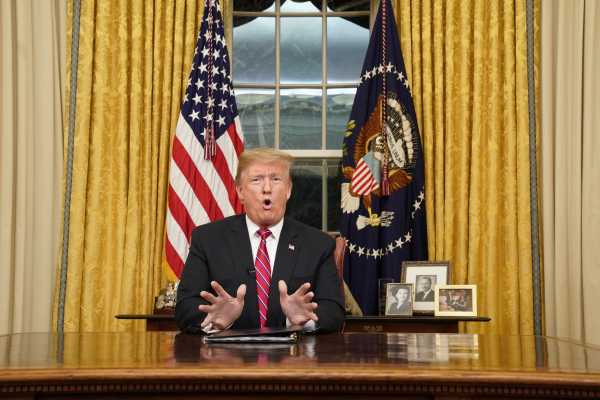
President Donald Trump used his Tuesday primetime Oval Office address to make the case for a border wall weeks into a partial government shutdown.
His speech included some false or misleading claims, including about funding for the barrier. One, specifically, involved the USMCA trade deal.
“The wall will also be paid for indirectly by the great new trade deal we have made with Mexico,” Trump said.
It’s a slightly more careful version of a similar argument he’s used before in press conferences and on Twitter: that Mexico will end up paying for the wall through the USMCA (United States-Mexico-Canada Agreement), the trilateral trade deal that’s an updated version of NAFTA.
One of Trump’s signature campaign promises hinged on the idea that the US would build a wall on the southern border, and he boasted — to cheering crowds — that Mexico would cover its cost. The problem now, of course, is Trump has refused to sign a spending bill to reopen the government unless he gets his wall. The USMCA line is an attempt to give him cover, and caveat his demand.
But Trump’s claim that either Mexico is paying for the wall through the USMCA or that the USMCA deal will “indirectly” finance the wall doesn’t add up.
For starters, the USMCA deal isn’t even in force. Leaders from the three countries signed the USMCA in November, but lawmakers in all three countries must still ratify the agreement. In the US, House Democrats have protested elements of the deal, and even if it makes it through the US Congress eventually and is approved by lawmakers in Mexico and Canada, provisions of the trade deal won’t go into effect until 2020, at the earliest.
The text of the USMCA doesn’t include any specific provisions about a wall or funding for any barrier — and experts say it’s extremely unlikely that if the trade deal is ratified, it will suddenly generate huge revenues for the US. And even if the US economy does grow as a result of the deal, leading to more tax revenue, the money will come from American taxpayers — whether consumers or businesses — and not from Mexico. (Trump, at least, seemed to account for this in his Oval Office speech.)
The USMCA “is not going to lead to the kinds of economic changes that the American people will even be able to notice, much less raise enough money to be able to pay for the wall,” Todd Tucker, a trade expert at the Roosevelt Institute, a liberal think tank, told me.
The US International Trade Commission, an independent federal agency, is expected to provide a trade assessment of USMCA by mid-March, which could clarify any potential economic benefits for the US, and over how long a period the benefits will exist. There’s just one small wrinkle: The agency, it turns out, has “ceased regular operations” because of the government shutdown wrought by Trump’s border wall. It might, Politico reported this week, miss its deadline.
The USMCA isn’t even close to being approved yet
The biggest hiccup in Trump’s claim that the USMCA will “indirectly” pay for the border wall is that it hasn’t become law yet.
Trump, Mexico’s then-President Enrique Peña Nieto, and Canadian Prime Minister Justin Trudeau all signed the trade pact at the G20 in November. But lawmakers in all three countries need to ratify the deal before it goes into effect.
Trump will need bipartisan support to get the USMCA passed. Given how the first several days of 2019 have played out, it’s fair to say the working relationship between Trump and House Democrats is a bit strained. Democrats are also unlikely to be interested in rubber-stamping one of the president’s signature promises.
Democrats have already expressed real reservations about the USMCA. (To be fair, so have Republicans — though it seems unlikely that they’ll buck the president here.) A Democratic aide told Politico that lawmakers want to adjust certain elements of the agreement, including rules and enforcement on labor and the environment.
“While there are positive things in this proposed trade agreement, it is just a list without real enforcement of the labor and environmental protections,” then-House Minority Leader Nancy Pelosi said in December, before Democrats took control of the chamber.
Lawmakers also don’t have a clear way to tweak the language of the USMCA. The US renegotiated NAFTA under Trade Promotion Authority (TPA), a law that empowers the president to negotiate trade deals and allows Congress to “fast-track” the agreement with an up-or-down vote. This doesn’t leave room for the House or Senate to make changes or introduce amendments.
If Democrats do demand major tweaks, they’d likely have to pressure the administration to reach some sort of side agreement on labor or environmental rules. Trump has threatened to withdraw from NAFTA altogether in an attempt to pressure Congress, though legal questions remain.
The USMCA is likely to set up another showdown between Democrats and the administration — and if this shutdown debacle is any sign, the USMCA won’t be paying for anything anytime soon.
Even if the USMCA does pass, the odds are extremely low that it will pay for the wall
The USMCA is basically a NAFTA 2.0, an updated version of the original agreement. Changes to the original agreement may affect certain industries, specifically auto manufacturers. But changes to NAFTA are probably not dramatic enough to really alter the trade relationship between the three countries — and none would put money directly into US coffers.
Without official estimates, it’s hard to gauge the potential impact of the USMCA on trade and the economy. There are ways the USMCA could generate revenue, but experts doubt it will be the dramatic windfall the president suggests. A lot of really surprising things would have to happen to get wall-level money. (And any revenue generated by USMCA would still need to be appropriated … by Congress.)
Job creation could generate income taxes, for example. New labor rules, the Trump administration hopes, will incentivize manufacturers to keep jobs in the US or relocate them there. Specifically, the USMCA calls for 40 to 45 percent of automobile components to be made by workers who earn at least $16 an hour by 2023 in order to trade tariff-free (and requires 30 percent by 2020). This provision specifically targets Mexico, with the goal of bringing wages there up to US and Canadian standards — or to, again, keep or attract jobs back to those places.
The result, in theory, would be that because of the USMCA, companies will be hiring more people and creating more jobs, which means more income tax revenue. But Clark Packard, a trade policy expert at the R Street Institute, told me that argument “is incredibly dubious.”
“Either way,” he added, “It’s American citizens that would be paying for this.”
In another twist, the US might be able to make some money — but the USMCA might actually have to be a failure for that to happen.
Here’s why: The essence of a free trade agreement is to support the free flow of goods by reducing trade barriers, things like tariffs and quotas. That’s what NAFTA does, and that’s also what the USMCA does.
In addition to those new labor regulations — like the $16-per-hour rule, mentioned above — another big update to the USMCA involves these so-called “rules of origins” for automakers. USMCA requires that 75 percent of auto components be manufactured in Mexico, the US, or Canada to qualify for zero tariffs. This is a substantial increase from 62.5 percent in the original NAFTA.
It’s not clear how auto companies are going to adjust to these USMCA requirements, but some experts speculate that it might be cheaper to pay tariffs on certain cars than rejigger supply chains. These would likely follow World Trade Organization rules; in the US, the tariff on most imported foreign cars is 2.5 percent.
“I haven’t seen any estimate that even if they do that, there would be enough revenue generated to pay for the wall — let alone Congress would use the money authorized … in that way,” Tucker from the Roosevelt Institute said. “But that’s conceivably one way that tariff revenue can be generated.”
Mexico still won’t be paying for the wall if that happens. US consumers and importers would foot the bill.
And even then, the USMCA — if it goes into effect — almost certainly won’t pay for Trump’s big, beautiful wall, or “Steel Slat Barrier,” or whatever we’re calling it these days.
Sourse: vox.com






